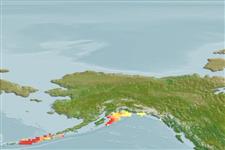Elasmobranchii (sharks and rays) >
Rajiformes (Skates and rays) >
Arhynchobatidae (Softnose skates)
Etymology: Bathyraja: Greek, bathys = deep + Latin, raja, -ae = a ray (Raja sp) (Ref. 45335); panthera: The name panthera is taken from the generic name of the leopard (Felidae), recognizing
the distinctive dorsal coloration of the species, often characterized by rosettes of black spots surrounding yellow blotches.
Issue
Sometimes placed in Arctoraja.
Environment: milieu / climate zone / depth range / distribution range
Ecology
Marine; demersal; depth range 51 - 258 m (Ref. 89865). Boreal, 170°E - 179°W
Pacific Ocean: Western Aleutian Islands and Petrel Bank.
Among species with subgenus Arctoraja, only B. panthera has been recorded west of 180° longitude in the Aleutian Islands, and the depth range in survey records of all skates recorded as 'B. parmifera' west of 180° longitude is 51-294 m (NMFS, AFSC, RACE survey database, 2009) (Ref. 89865).
Size / Weight / Age
Maturity: Lm ? range ? - ? cm
Max length : 111 cm TL male/unsexed; (Ref. 89865)
Short description
Identification keys | Morphology | Morphometrics
This species is distinguished from all other members of the subgenus Arctoraja by the following: body coloration light greenish brown, with vermiculated and round black spots and yellow blotches; distal tip of ventral marginal sinusoidal; accessory terminal 2 elongate and broad, with long spike; distal tip of axial cartilage pointed; unique COI haplotype. Bathyraja panthera is further distinguished from B. parmifera by its total thorn count 31-42 (vs. 19-36), tail thorn count 19-28 (vs. 15-23), internal carotid foramina in a single median pit (vs. foramina widely separated), distal portion of ventral marginal cartilage sinusoidal (vs. straight), accessory terminal 2 elongate with long spike (vs. broadly triangular with short spike), distal tip of axial cartilage pointed (vs. bluntly rounded), anterior portion of body longer and wider (vs. shorter and narrower), tail long (vs. short); from B. simoterus by its wide interdorsal space 1.4-3.1% TL (vs. 0.5-1.0% TL), anterior portion of body longer and wider (vs. shorter and narrower), tail longer (vs. shorter), posterior fontanelle pear-shaped (vs. narrowly elongate), internal carotid foramina in a single median pit (vs. widely separated foramina), anterior postdorsal foramen of scapulocoracoid large, others much smaller (vs. all large), ventral terminal tear-drop shaped (vs. lanceolate); from B. smirnovi by its complete series of dorsal thorns (vs. interrupted series between nuchal and tail thorns), wider interdorsal length (vs. 0.1-1.4% TL), anterior portion of body longer and wider (vs. shorter and narrower), tail longer (vs. shorter), separate anterior and posterior fontanelles (vs. single fontanelle), ventral terminal tear-drop shaped (vs. lanceolate), dorsal and ventral marginals extending to about a quarter length of dorsal terminal 2 (vs. extending farther distally to distal tip of dorsal terminal 3) (Ref. 89865).
Maximum length observed was 139 cm TL (Ref. 89865).
Life cycle and mating behavior
Maturity | Reproduction | Spawning | Eggs | Fecundity | Larvae
Orr, J.W., Stevenson, D.E., Hoff, G.R., Spies, I. and J.D. McEachran, 2011. Bathyraja panthera, a new species of skate (Rajidae: Arhynchobatinae) from the western Aleutian Islands, and resurrection of the subgenus Arctoraja Ishiyama. NOAA Professional Paper NMFS 11:50pp (Ref. 89865)
IUCN Red List Status (Ref. 130435: Version 2024-1)
Threat to humans
Harmless
Human uses
Tools
Special reports
Download XML
Internet sources
Estimates based on models
Preferred temperature (Ref.
123201): 4.2 - 5.9, mean 4.7 °C (based on 49 cells).
Phylogenetic diversity index (Ref.
82804): PD
50 = 0.5000 [Uniqueness, from 0.5 = low to 2.0 = high].
Bayesian length-weight: a=0.00550 (0.00291 - 0.01038), b=3.13 (2.97 - 3.29), in cm total length, based on LWR estimates for this Genus-body shape (Ref.
93245).
Trophic level (Ref.
69278): 4.0 ±0.7 se; based on size and trophs of closest relatives
Fishing Vulnerability (Ref.
59153): High to very high vulnerability (67 of 100).
